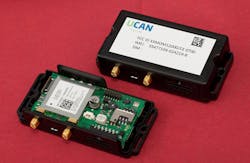Eindhoven Is Proving Ground For Improving Traffic Flow
As automobiles are designed with more intelligence, they can share what they “know” to improve traffic safety. In a 12-month smarter-traffic trial in Eindhoven, The Netherlands, IBM and NXP Semiconductors demonstrated how the connected car can automatically transmit braking, acceleration, and location data. Such data can be analyzed by the central traffic authority to identify and resolve road network issues.
During the trial, IBM, NXP, and their partners equipped 200 participating cars with a device containing the NXP telematics chip, “ATOP” (see figure). It gathers relevant data from the car’s central communication system using the automotive controller-area-network (CAN) bus. Relevant sensor data, such as indicators of potholes or icy roads, was collected in-vehicle and transmitted to the cloud-enabled IBM Smarter Traffic Center.
Related Articles
• Compact Automotive Antennas Juggle Multiple Bands
• Resistor Pairs Fill Automotive Needs
• Expect An Upsurge In Automotive Assistance Features
Using IBM analytics, raw data from the vehicles highlighted 48,000 incidents over a period of six months from 1.8 billion sensor signals. Incidents included heavy rain, black spots, the turning on of hazard lights, or fog. The disparate data from thousands of sensors was managed and analyzed through the IBM SmartCloud Enterprise service.
In addition to informing road officials, this data can warn nearby drivers of an incident through a smartphone or built-in navigation device. For example, a new speed will be recommended based on current weather and road conditions via a mobile application. In the future, a traffic command center could provide more personalized detours, routes, and traffic information to a driver to better avoid congestion.
About the Author

Nancy Friedrich
RF Product Marketing Manager for Aerospace Defense, Keysight Technologies
Nancy Friedrich is RF Product Marketing Manager for Aerospace Defense at Keysight Technologies. Nancy Friedrich started a career in engineering media about two decades ago with a stint editing copy and writing news for Electronic Design. A few years later, she began writing full time as technology editor at Wireless Systems Design. In 2005, Nancy was named editor-in-chief of Microwaves & RF, a position she held (along with other positions as group content head) until 2018. Nancy then moved to a position at UBM, where she was editor-in-chief of Design News and content director for tradeshows including DesignCon, ESC, and the Smart Manufacturing shows.
